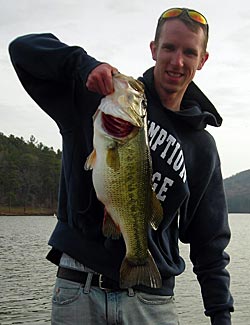
If you’re a bass angler, you know about the magic of the prespawn fishing season. But do you know when it begins, where to look for bass or how to adjust to changing conditions?
That’s the difference between anglers who catch quality fish consistently throughout the prespawn season and those who have more bad days than good ones.
It all begins once winter winds down and the days become longer and warmer. The warmth stimulates activity throughout the food chain and lures bass from their deep, winter haunts. And although bass are feeding more frequently, remember that their spawning urges are key factors in what draws them shallow.
Most anglers think of the prespawn season as a period when bass are cruising potential shallow-water nesting areas. The good fishing begins long before then.
Think of it as a three-stage cycle that runs two months or longer. The first stage occurs when bass start moving out of wintering areas and schooling on main lake points and ledges. Then, as the water warms faster, they filter onto secondary points and creek channels before finally buckling down on actual spawning flats to begin nesting operations.
I like to intercept prespawners when they’re staging on lake ledges and major points – the same deep areas I’ll fish during the heat of the summer after the spawn. The early staging fish can be extremely aggressive and easy to catch, yet they often are neglected by anglers who prefer to wait for them to move onto secondary points or into shallow water. If you fish often, you can follow those deep fish as they migrate closer to spawning areas with each warming day.
Although a wide variety of lures work during prespawn, you can count on a crankbait, jig-and-pig or spinnerbait to produce most of the time. My preference depends upon the structure, but early in the season I’ll use a crankbait that runs deep because it gets down to where the fish are and allows me to cover a lot of water. You can probably catch fish on smaller crankbaits during the prespawn, but I’m looking for giants.
Water temperature is a deciding factor in where and how to fish during the prespawn. If the water temperature is below 58 degrees I know to slow down my lure presentation. If it’s warmer, I’ll choose lures that cover water more quickly. Also, if the sun is shining on a calm day, I know the water temperature will rise throughout the day and the fish likely will change their mood.
That’s important to remember, because what works in the morning may not work in the afternoon. For example, if during the late prespawn season you’re catching bass by pitching a heavy jig into the bushes and the pattern dies, don’t assume the fish have left the cover. What probably happened is the bass have moved nearer to the surface to suspend in the bushes where the water is warmer. The heavy jig is dropping too quickly; therefore, a change to a floating worm or spinnerbait might be more productive.
Water clarity can make a difference, too. Spring rains can muddy shallows that held bass the week before. That mud chases a lot of anglers to other areas in search of clearer water, but not me. Muddy water moves bass closer to the banks where they can be caught on a jig or spinnerbait, especially when water temperatures are 58 degrees or more.
My final advice for red-hot prespawn action is to look for unmolested fish. Probe those areas that are overlooked by other anglers and you may stumble into a fishing day you’ll remember forever.
You can find more articles, quick tips and much more at HankParker.com.




